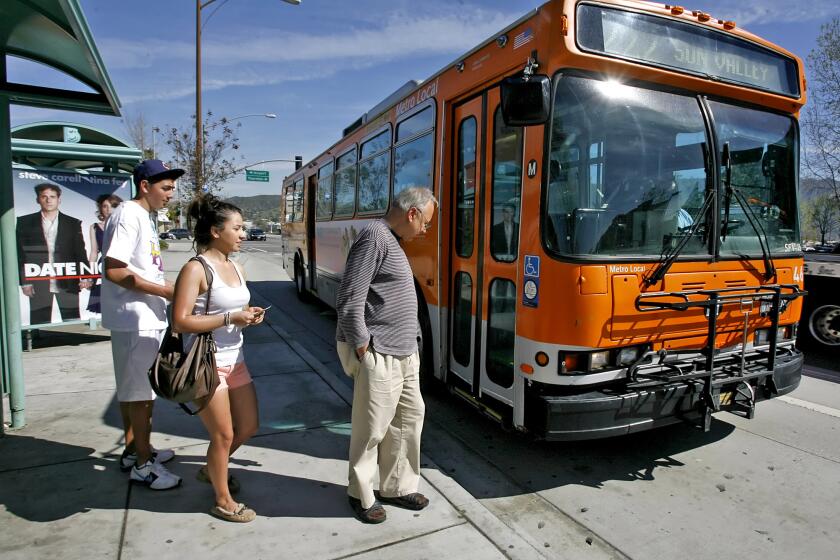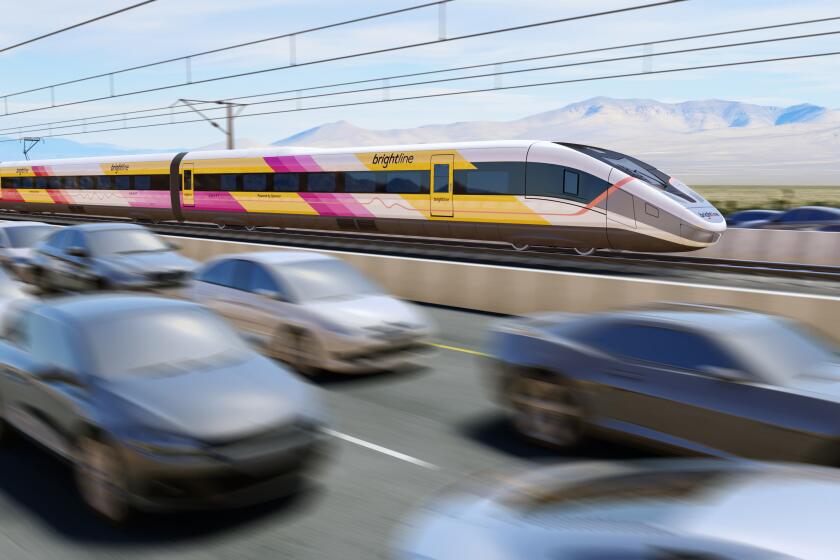Electric Vehicles a Perk for the Public
Free municipal services used to mean checking out a library book. But in Anaheim these days, some residents can borrow an electric car. All it takes is a valid license and a decent driving record.
The cars are part of a $300,000 state pilot program to cut pollution and introduce the zippy, gas-free vehicles into neighborhoods.
Although San Jose, Palm Springs and Sebastopol also received grants, Anaheim’s program has a unique twist.
Instead of shuttling tourists or city staffers, Anaheim’s 10 electric cars go into redevelopment areas, giving low- to moderate-income residents a chance to use the cars to drop off children at school, deposit checks at the bank or run to the grocery store.
And although families that might not own a car--or occasionally need a second set of wheels--benefit, the program also reduces pollution.
Whenever they appear on Anaheim streets, the cars attract gawkers who are more accustomed to seeing the golf cart-like vehicles in upscale retirement communities or on Santa Catalina Island than in the parking lot at the neighborhood Ralphs.
“The only problem is that any time you go anywhere, you have to answer questions for 10 to 15 minutes,” said Laurie Smith, director of the Anaheim Transportation Network, a nonprofit agency that provides alternative transit in the city.
Residents must first have their driving records checked and be approved for the program. The transportation network bears the liability for the cars, paying about $110 a month per vehicle for auto insurance.
The cars, called neighborhood electric vehicles, are not designed to replace full-size cars, said Tom Zabriskie, Global Electric Motorcars division manager for Quality Car Co., a Midway City dealership that sells the vehicles.
“It’s designed for 75% of those trips we take that are local,” he said.
Those quick neighborhood trips account for about 85% of the pollution from cars, according to air quality statistics.
In Palm Springs, city employees use electric vehicles to run short errands. In Sebastopol, a meter reader makes his stops in the electric car.
Anaheim already has several clean-air programs, including one that allows commuters to lease an electric Toyota RAV4 to park at a Metrolink station, then use it for the short drive to work.
The grant from the California Energy Commission provided the vehicles to offer programs for lower- and moderate-income people as well, said RoseMary Bledsoe, manager of the transportation network’s ride-share programs.
At Paseo Village, where five cars were placed in April, family income levels start at $19,000 annually and range up to $51,000. Two more cars were added to Park Vista a few weeks ago, and by December, some will be parked at a redeveloped community at Jeffrey-Lynne.
So far, more than a dozen families at the 174-unit Paseo Village apartment complex have been approved to drive the electric cars, and several more are pending approval. Those who drive the cars can’t wait to check them out again. “They come back with a big smile on their face,” said Griselda Ortiz, an administrative assistant at the complex.
“I like it. It’s so convenient,” said Gabby Castelan, a resident of Paseo Village, one of the two redeveloped apartment complexes that house the cars.
“We use them all the time,” she said. “We go everywhere--to pick up my daughter at school, to the post office, to get lunch.”
Castelan can’t actually get behind the wheel yet because she is waiting for the Anaheim Transportation Network to finish processing her application. For now, she relies on her friend, Ortiz, who has been cleared to drive the vehicles.
The program is open to residents with a valid driver’s license who live at the complexes where the cars are garaged. Anaheim Transportation Network officials run the Department of Motor Vehicles checks, mostly in search of major violations, such as auto theft or driving under the influence.
Residents who have a few minor traffic tickets on their records are still allowed to check out the cars.
The car’s sticker price starts at about $7,000 for the simple, no-frills two-seater. But it can be upgraded with add-ons such as doors, a CD player, fabric seats and a trunk.
Anaheim has the four-seater model with a trunk that sells for $10,000.
It is legal on city streets with a speed limit of 35 mph or less and comes in an assortment of colors. All it takes to recharge is a standard 110-volt household outlet.
After neighborhood informational meetings, the Anaheim program is catching on slowly, but there are still long stretches when the cars sit unused, Bledsoe said.
“It’s new technology and a new concept,” Bledsoe said. “We figure it will be about a year before we have these busy all day, every day.”
More to Read
Start your day right
Sign up for Essential California for news, features and recommendations from the L.A. Times and beyond in your inbox six days a week.
You may occasionally receive promotional content from the Los Angeles Times.







